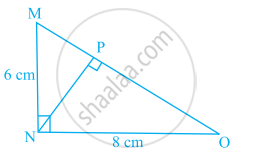Advertisements
Advertisements
प्रश्न
Find the area of Δ ABC whose vertices are:
A (1,2) B (-2,3) and C (-3,-4)
उत्तर
A (1,2) B (-2,3) and C (-3,-4) are the vertices of . ΔABC Then,
`(x_1 =1,y_1=2),(x_2=-2,y_2=3) and (x_3=-3,y_3=-4)`
Area of triangle ABC
`=1/2 {x_1(y_2-y_3)+x_2(y_3-y_1)+x_3(y_1-y_2)}`
` = 1/2 { 1(3-(-4))+(-2)(-4-2) + (-3)(2-3)}`
`=1/2 { 1(3+4)-2(-6) -3 (-1)}`
`=1/2 {7+12+3}`
`=1/2 (22)`
= 11 sq. units
APPEARS IN
संबंधित प्रश्न
If the points A(x, 2), B(−3, −4) and C(7, − 5) are collinear, then the value of x is:
(A) −63
(B) 63
(C) 60
(D) −60
The area of a triangle is 5 sq units. Two of its vertices are (2, 1) and (3, –2). If the third vertex is (`7/2`, y). Find the value of y
Find the area of a triangle whose vertices are
(6,3), (-3,5) and (4,2)
Find the area of a triangle whose sides are 9 cm, 12 cm and 15 cm ?
Show that the points A(-5,6), B(3,0) and C(9,8) are the vertices of an isosceles right-angled triangle. Calculate its area.
For what values of k are the points A(8, 1) B(3, -2k) and C(k, -5) collinear.
Show that ∆ ABC with vertices A (–2, 0), B (0, 2) and C (2, 0) is similar to ∆ DEF with vertices D (–4, 0), F (4, 0) and E (0, 4) ?
If the area of triangle ABC formed by A(x, y), B(1, 2) and C(2, 1) is 6 square units, then prove that x + y = 15 ?
Using integration, find the area of triangle ABC, whose vertices are A(2, 5), B(4, 7) and C(6, 2).
In the given figure, ΔMNO is a right-angled triangle. Its legs are 6 cm and 8 cm long. Length of perpendicular NP on the side MO is ______.

